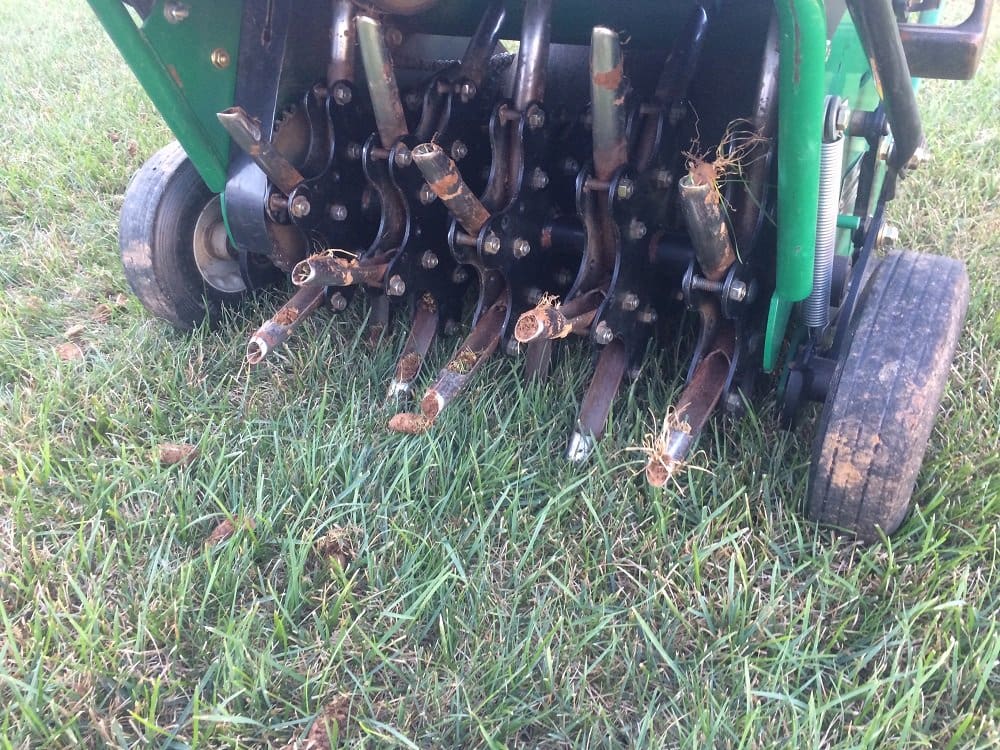
Fall is well underway and with it comes a number of necessary tasks to prepare the lawn for a strong start in the spring. Below are some answers to some common questions.
Why are aeration and seeding so important for cool-season grasses?
Aeration and overseeding are important cultural practices for cool-season grasses. Aeration alleviates soil compaction, reduces thatch build-up, improves water and oxygen in the soil, and stimulates microbial activity. Its impact on lawns is faster recovery from summer stress and overall better growth and health before the winter months and dormancy set it. Seeding is often recommended with aeration as it helps with the introduction of a new variety of seeds and helps improve the lawn’s appearance and health.
Should cool-season grasses be seeded even if they don’t have patchy areas?
The overseeding of cool-season grasses is to introduce new seed cultivars which will improve the genetic diversity of the turfgrass stand. Newer varieties may have better drought and disease tolerance than what was originally installed when the lawn was established. Overseeding is not intended to repair or renovate bare spots and damaged areas.
When is it too late to seed cool-season grasses?
Depending on the geography it is best to seed when there is enough time left for the seed to germinate and establish before the winter months. As a good gauge, most LCOs will start their aeration and seeding in late summer and be done by no later than mid-November or earlier. It is definitely too late to seed once the soil temperatures dip below 40 degrees F, as the days get too short and there is a higher risk for overnight air temperature below freezing. These conditions can have an impact on the survival of young seedlings.
In cool-season turfgrass, fall is also the optimum time to apply postemergence herbicides for difficult-to-control perennial weeds such as wild violet and dandelion. During the fall, perennial weeds translocate carbohydrate reserves into the root structures for winter survival and energy source for spring emergence. Systemic broadleaf weed herbicides applied during this time provide more effective long-term control due to their impact on underground reproductive structures for these weeds. Typically, fall-applied herbicides in warm-season turfgrass are preemergence herbicides for winter annual weed control.
What are the benefits of applying fall preemergence herbicides?
Fall preemergence herbicides applied to warm-season turfgrass aid in controlling winter annual weeds that disrupt the turfgrass canopy. Without a preemergence application, these weeds can create voids in the turfgrass, which provide opportunities for other winter weeds to emerge. As these weeds persist in spring, summer annual weeds like crabgrass and goosegrass can fill in once these winter weeds naturally senesce. In turfgrass weed management, it is important LCOs utilize all tools needed to break these weed cycles to provide high-quality turfgrass to their customers.
Should fall herbicides only be applied to warm-season, cool-season or both types of grass?
There are benefits to fall applications in both cool and warm-season turfgrasses. The major differences between the two are weed spectrum and application types. LCOs managing warm-season turfgrasses may rely more on preemergence herbicide applications to control weeds like annual bluegrass, henbit, lawn burweed, and other winter annual weeds. Postemergence broadleaf weed control is the primary fall application type for cool-season turfgrass managers. However, when weeds are present in dormant warm-season grasses, post-emergent herbicides can be used as well.
When is it too late to apply Poa annua preemergence applications for warm-season grasses?
Annual bluegrass (Poa annua) emergence can be highly variable in fall. In general, peak annual bluegrass emergence occurs when soil temperatures are consistently between 65 – 70 F at a 2-inch depth. However, it is common to see emergence in smaller areas occur prior to that given moisture requirements are met. Additionally, this weed can have a late flush of germination later in the fall. Preemergence herbicides applied after peak emergence will not provide effective control.
Does a liquid or granular preemergence herbicide work better in the fall?
Effective preemergence weed control can be achieved with both liquid and granular herbicide formulations. If using liquid formulations, ensure adequate spray volume is used to deliver the active ingredient through the upper canopy. For granular formulations, it is important to use a particle size and spread rate to provide even coverage to deliver the desired use rate. Either formulation will need to be incorporated with rainfall or irrigation to activate the product.
Created in partnership with the experts at FMC True Champions

